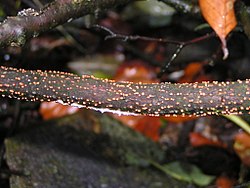Bob
Have a question related to this hub?
Alice
Got something to say related to this hub?
Share it here.
| Nectriaceae | |
|---|---|

| |
| Nectria cinnabarina | |
| Scientific classification | |
| Kingdom: | Fungi |
| Division: | Ascomycota |
| Class: | Sordariomycetes |
| Order: | Hypocreales |
| Family: | Nectriaceae Tul. & C.Tul. (1844) |
| Type genus | |
| Nectria (Fr.) Fr. (1849)
| |
| Genera | |
|
See text | |
The Nectriaceae comprise a family of fungi in the order Hypocreales. It was circumscribed by brothers Charles and Louis René Tulasne in 1865.[1] In 2020, an Outline of fungi was produced and listed 70 genera and about 1,336 species.[2]
It is a highly diverse group with a worldwide distribution and it has higher diversity in warm temperate and tropical regions (Rossman et al. 1999;[3] Rossman 2000; Chaverri et al. 2011, Schroers et al. 2011,[4] Hyde et al. 2014, Lombard et al. 2015,[5]). Several authors have studied and revised the taxonomy of Nectriaceae (Petch 1938;[6] Munk 1957; Dennis 1960; Kreisel 1969; Rossman et al. 1999;[3] Lumbsch and Huhndorf 2010; Lombard et al. 2015; Maharachchikumbura et al. 2016b).[7] A recent treatment of Nectriaceae was provided by Wijayawardene et al. (2022), they also accepted 70 genera within the family.[8]
As accepted by Wijayawardene et al. 2020; (with number of species)[2]